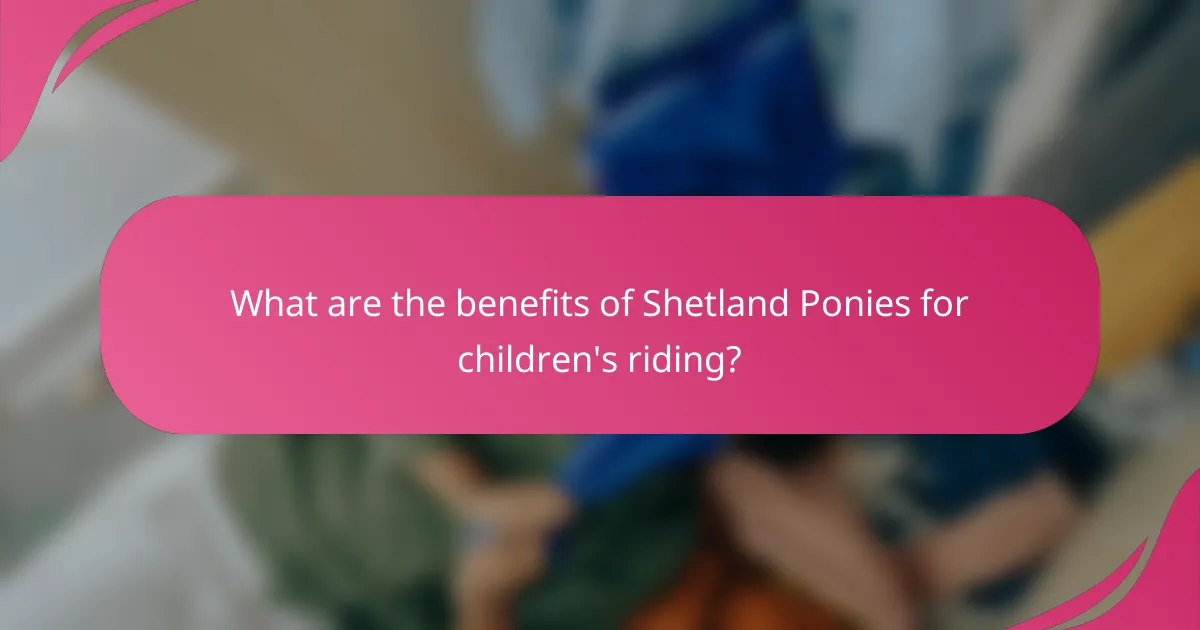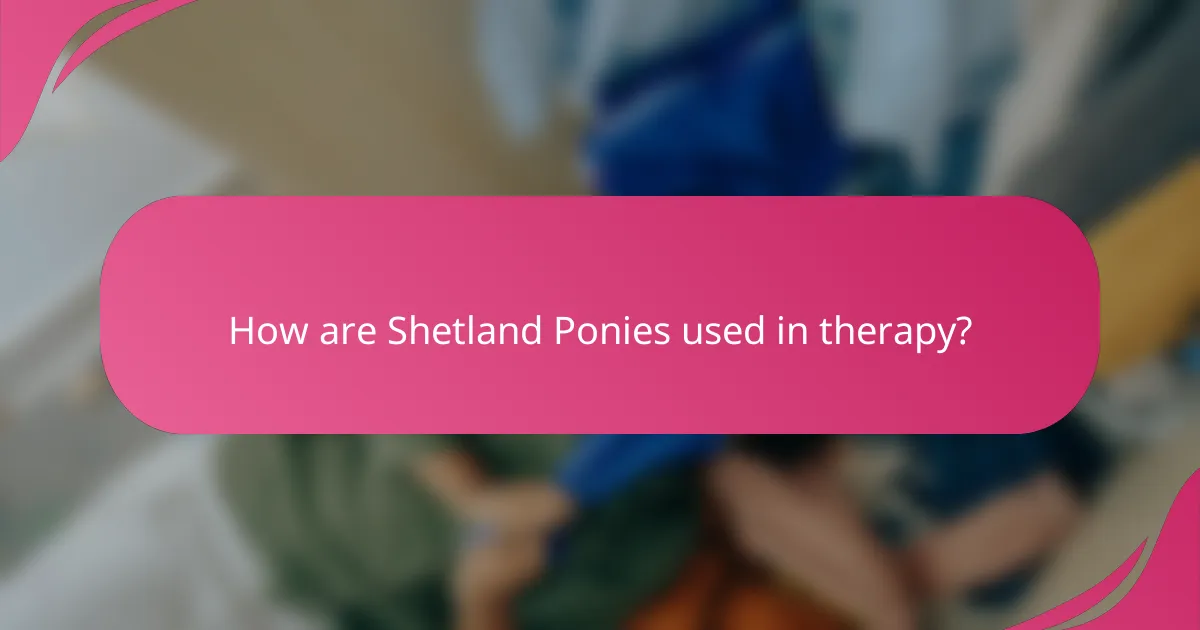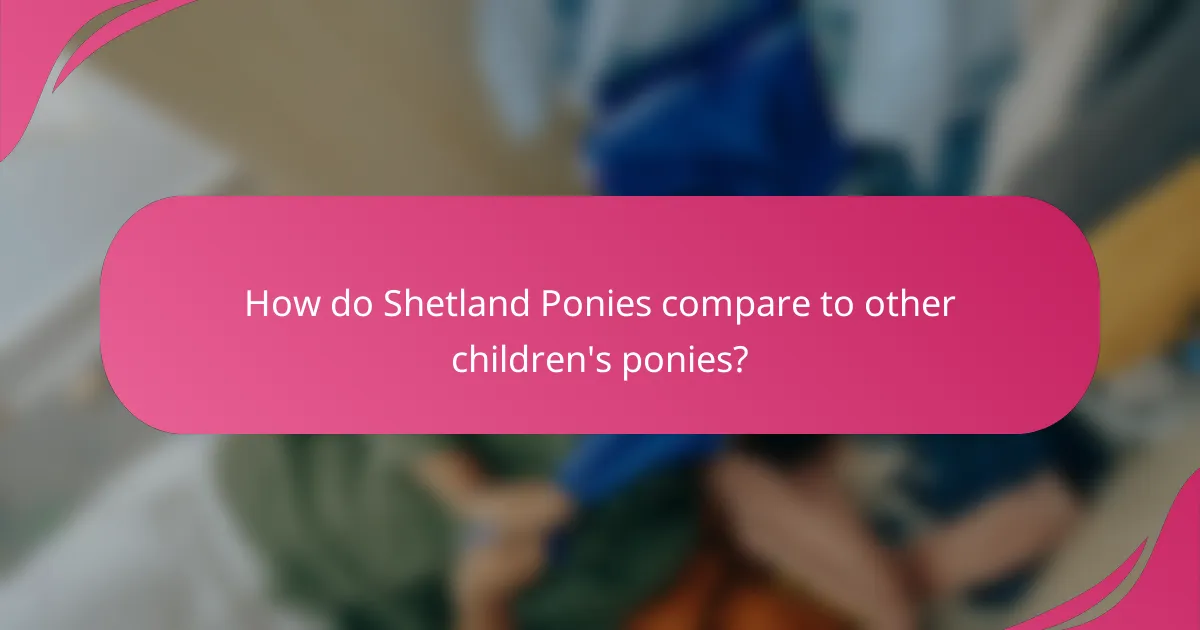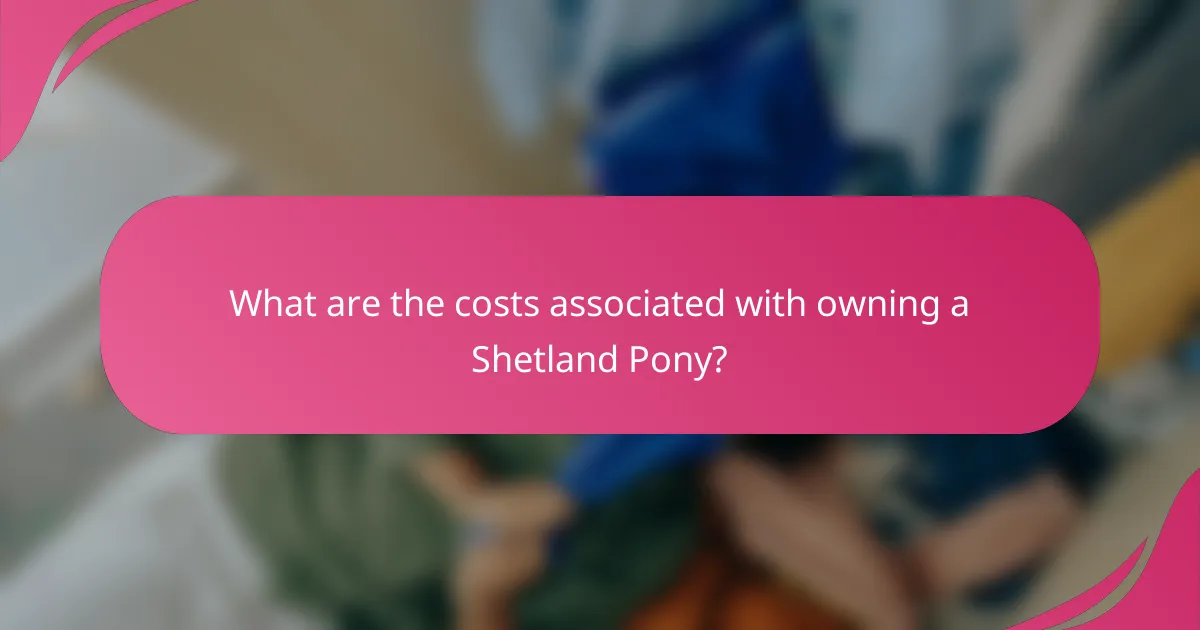Shetland Ponies are an excellent choice for children’s riding, thanks to their gentle disposition, manageable size, and ease of training, creating a safe environment for young riders. Additionally, their small stature and friendly nature make them ideal for therapy programs, providing emotional support and engagement for individuals with diverse needs. Versatile in their abilities, Shetland Ponies also excel in driving activities, from leisurely carriage rides to competitive events.

What are the benefits of Shetland Ponies for children’s riding?
Shetland Ponies offer numerous benefits for children’s riding, including their gentle nature, manageable size, and ease of training. These attributes make them ideal companions for young riders, fostering a safe and enjoyable learning environment.
Gentle temperament
Shetland Ponies are known for their calm and friendly demeanor, which is crucial for children’s riding experiences. Their gentle temperament helps build confidence in young riders, allowing them to feel secure while learning to ride.
This breed typically exhibits patience and a willingness to cooperate, making them less likely to spook or react unpredictably. Such traits are essential for creating a positive atmosphere during riding lessons.
Size suitability for children
The compact size of Shetland Ponies makes them particularly suitable for children. Standing around 28 to 42 inches tall, they are easy for young riders to mount and dismount, reducing the risk of accidents.
Additionally, their smaller stature allows children to handle them more easily, promoting independence and responsibility as they learn to care for and ride their pony.
Easy to train
Shetland Ponies are generally easy to train, which is beneficial for both children and instructors. Their intelligence and eagerness to please make them quick learners, allowing children to progress in their riding skills more rapidly.
When training a Shetland Pony, consistency and positive reinforcement are key. Simple commands and reward-based training methods can lead to effective results, making the learning process enjoyable for both the child and the pony.

How are Shetland Ponies used in therapy?
Shetland Ponies are commonly used in therapy due to their gentle nature and small size, making them ideal for children and individuals with various needs. They participate in equine-assisted therapy programs, providing emotional support and physical engagement that can enhance overall well-being.
Equine-assisted therapy programs
Equine-assisted therapy programs often involve structured activities where participants interact with Shetland Ponies under the guidance of trained professionals. These programs can include grooming, feeding, and riding, which help build trust and improve communication skills. Sessions typically last from 30 minutes to an hour, depending on the participants’ needs and abilities.
In these programs, the focus is not solely on riding but also on developing a bond with the pony, which can lead to emotional healing and personal growth. Many facilities offer tailored sessions that accommodate different therapeutic goals, such as anxiety reduction or social skills development.
Benefits for children with disabilities
Shetland Ponies provide numerous benefits for children with disabilities, including improved motor skills, increased confidence, and enhanced emotional regulation. The act of riding or caring for a pony can promote physical coordination and balance, which are crucial for children with mobility challenges.
Additionally, interacting with these ponies can foster social interactions and reduce feelings of isolation. Many parents report significant improvements in their children’s mood and behavior after participating in equine therapy, highlighting the positive impact of this unique approach to therapy.

What driving activities can Shetland Ponies participate in?
Shetland Ponies are versatile and can engage in various driving activities, including carriage driving and competitive driving events. Their small size and friendly temperament make them ideal for both recreational and competitive driving experiences.
Carriage driving
Carriage driving involves guiding a pony while pulling a two- or four-wheeled carriage. This activity can be enjoyed leisurely or used for transportation. Shetland Ponies are well-suited for this due to their strength relative to size, making them capable of pulling lightweight carriages with ease.
When considering carriage driving, ensure the carriage is appropriately sized for the pony. A well-fitted harness is crucial for comfort and safety. Regular training and practice will help the pony become accustomed to the carriage and improve handling skills.
Competitive driving events
Competitive driving events showcase the skills of ponies and their drivers in various disciplines, such as dressage, cones, and marathon driving. Shetland Ponies can compete in these events, often excelling due to their agility and responsiveness.
Before entering competitions, familiarize yourself with the specific rules and requirements of the event. Training should focus on building the pony’s confidence and skills in each discipline. It’s also beneficial to participate in local competitions to gain experience and connect with other driving enthusiasts.

What are the care requirements for Shetland Ponies?
Caring for Shetland Ponies involves proper feeding, grooming, and regular health checks to ensure their well-being. These small yet sturdy ponies require attention to their specific needs to thrive in various environments, whether for riding, therapy, or driving.
Feeding and nutrition
Shetland Ponies require a balanced diet that typically includes high-quality hay, pasture, and specially formulated pony feed. Due to their small size and tendency to gain weight, portion control is essential, with daily feed amounts generally ranging from 1.5% to 2% of their body weight.
It’s crucial to monitor their body condition and adjust their diet accordingly, especially if they are less active. Providing fresh water at all times and avoiding overfeeding treats can help maintain their health.
Grooming and health checks
Regular grooming is vital for Shetland Ponies to keep their coats clean and free from parasites. Grooming sessions should include brushing to remove dirt and loose hair, as well as checking for any skin issues or injuries.
Health checks should be conducted at least once a month and include inspecting their hooves, teeth, and overall body condition. Routine veterinary care, including vaccinations and dental check-ups, is also recommended to prevent health issues.

What should you consider when selecting a Shetland Pony?
When selecting a Shetland Pony, it’s essential to consider factors such as the pony’s age, experience level, and temperament. These elements significantly influence the pony’s suitability for children’s riding, therapy, or driving activities.
Age and experience level
The age of the Shetland Pony can impact its suitability for children. Younger ponies, typically under five years old, may require more training and handling, while older ponies often have more experience and a calmer demeanor. For beginners, a pony aged between five to ten years is usually ideal, as they tend to be more reliable and easier to manage.
Additionally, consider the pony’s experience level with children. A pony that has been previously used for riding or therapy with kids will likely be more accustomed to their behavior and needs. Look for ponies with a proven track record in these areas to ensure a positive experience.
Temperament and behavior
The temperament of a Shetland Pony is crucial when selecting one for children. A calm, friendly, and patient pony is best suited for young riders or therapy work. Look for traits such as curiosity and willingness to engage, as these indicate a pony that is likely to bond well with children.
It’s also important to assess the pony’s behavior in various situations. Ponies that are easily startled or aggressive may not be suitable for children. Observing the pony in a controlled environment can help gauge its reactions and ensure it is a good match for the intended purpose, whether that’s riding, therapy, or driving.

How do Shetland Ponies compare to other children’s ponies?
Shetland Ponies are often preferred for children’s riding due to their manageable size, gentle temperament, and versatility in various activities. Compared to other children’s ponies, they stand out for their strength and adaptability, making them suitable for both riding and driving.
Comparison with Welsh Ponies
Welsh Ponies are generally larger and more spirited than Shetland Ponies, which can make them less suitable for very young riders. While both breeds are known for their friendly nature, Shetlands are often more patient and forgiving, ideal for beginners. Welsh Ponies excel in competitive events, but Shetlands are versatile for casual riding and therapy work.
Comparison with Miniature Horses
Miniature Horses are typically smaller than Shetland Ponies and are often used for therapy and companionship rather than riding. While they share a gentle demeanor, Shetlands are more robust and can carry more weight, making them better suited for riding activities. Miniature Horses may require specialized care due to their size, while Shetlands are generally easier to manage in various environments.

What are the costs associated with owning a Shetland Pony?
Owning a Shetland Pony involves various costs, including initial purchase price, ongoing care, and additional expenses for training and equipment. Prospective owners should budget for these factors to ensure they can provide a suitable environment for their pony.
Initial Purchase Price
The initial cost of a Shetland Pony can vary significantly based on age, training, and pedigree. Prices typically range from a few hundred to several thousand dollars. It’s essential to research and find a reputable breeder or seller to ensure a healthy pony.
Ongoing Care Costs
Ongoing care for a Shetland Pony includes feed, veterinary care, and hoof maintenance. Monthly expenses can range from $100 to $300, depending on the pony’s health and dietary needs. Regular vaccinations and dental check-ups are also necessary to maintain good health.
Training and Equipment Expenses
Training costs can vary widely, depending on whether you choose professional training or do it yourself. Professional training can cost anywhere from $30 to $100 per session. Additionally, equipment such as saddles, bridles, and grooming supplies can add several hundred dollars to your initial investment.


